Moving into a new home with your cat is exciting, but it can also be stressful for them. Cats are creatures of habit and very territorial, so unfamiliar surroundings may make them feel anxious or overwhelmed.
Helping your cat settle in takes time, patience and the right approach. We recommend creating a safe and comfortable environment, keeping routines consistent and gradually introducing new spaces.
With the right plan, you can make the transition as smooth as possible.
This guide will walk you through seven proven methods to help your cat feel secure and happy in your new home.
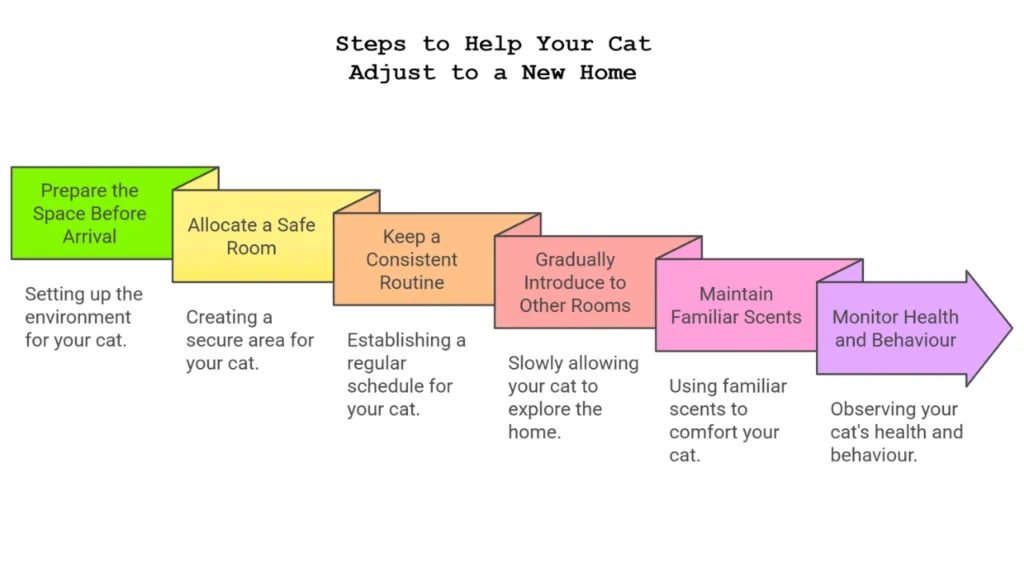
Step 1: Prepare the Space Before Arrival
Bringing your cat into a new home can be overwhelming for them. Preparing the space in advance helps create a safe and comfortable environment, making the transition smoother.
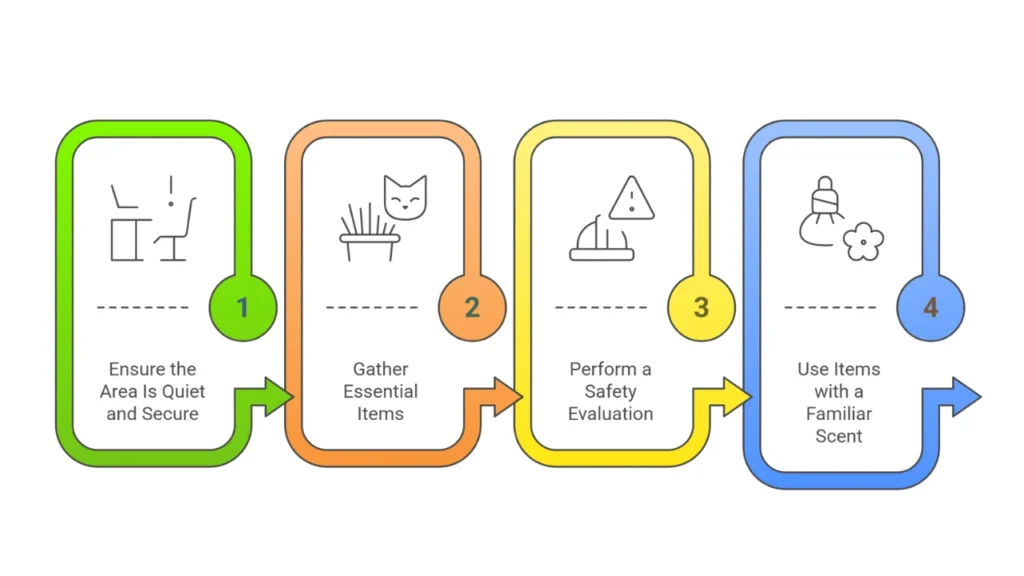
Ensure the Area Is Quiet and Secure
Cats feel safer in calm and quiet spaces. Choose a low-traffic room away from loud noises, other pets and sudden disturbances.
Close windows and secure doors to prevent escape attempts, as some cats may try to hide or run away when feeling stressed.
Gather Essential Items Like Litter Box, Bedding and Toys
Having all necessary items ready before your cat arrives helps them feel settled and comfortable. Essential items include:
- A litter box in a private, accessible area
- A comfortable bed or blanket to rest on
- Food and water bowls, away from the litter box
- Scratching posts and toys to keep them entertained and reduce stress
Perform a Safety Evaluation
Check your new home for any potential hazards. Look for small spaces where your cat could get stuck and block them off.
Remove toxic plants, chemicals and small objects that could be swallowed. Keep electrical cords and fragile items out of reach to prevent accidents.
Use Items with a Familiar Scent
Familiar scents often help ease anxiety and make the space feel like home. Keep an item from their previous home – such as a blanket, bed or toy.
You can also use a pheromone spray or diffuser to create a calming atmosphere.
Preparing the space before your cat arrives reduces stress and creates a welcoming environment for them to explore at their own pace.
Step 2: Allocate a Safe Room
When introducing your cat to a new home, it’s vital to limit their space at first. A safe room helps them adjust gradually and feel more secure.
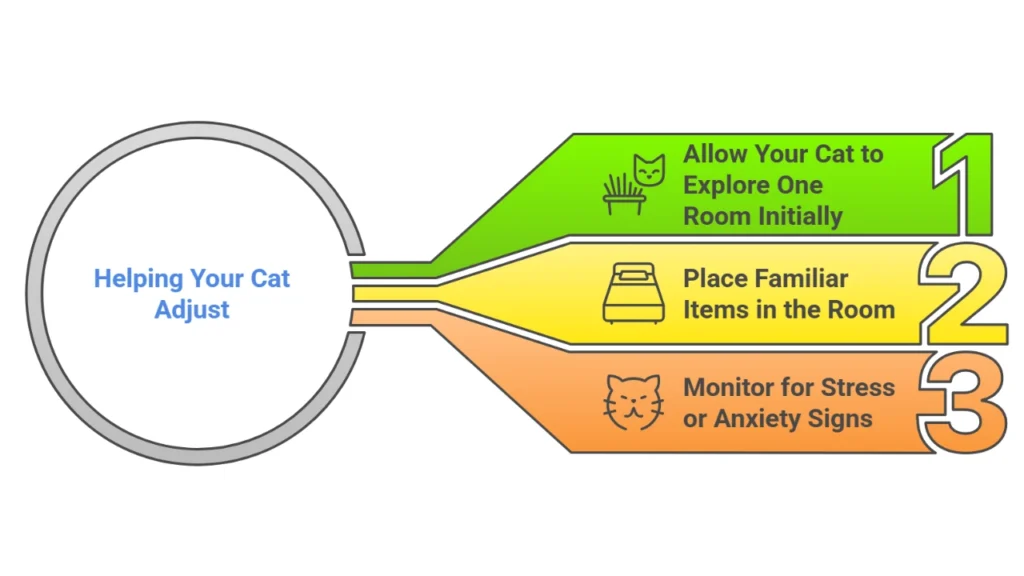
Allow Your Cat to Explore One Room Initially
Start by keeping your cat in one quiet room with a door that closes securely. This lets your cat adjust to new smells and sounds without feeling overwhelmed.
Never force them out of their safe space – let them explore at their own pace.
Place Familiar Items in the Room
Having familiar scents in the room can make your cat feel more comfortable. Place items in the room like:
- Their bed or blanket from their previous home
- A litter box in a quiet corner, away from food and water
- Toys and a scratching post to help them release stress
Monitor for Stress or Anxiety Signs
Keep an eye on your cat’s behaviour for signs of stress or fear, such as:
- Hiding for long periods
- Refusing to eat or drink
- Excessive meowing or hissing
If your cat seems anxious, give them time and space. Avoid handling them too much at first and let them approach you when ready.
Step 3: Keep a Consistent Routine
Like dogs, cats thrive on routine. Keeping their daily schedule predictable helps them feel safe and secure in a new home. Sudden changes can cause stress, so it’s crucial to maintain consistency in unfamiliar surroundings.
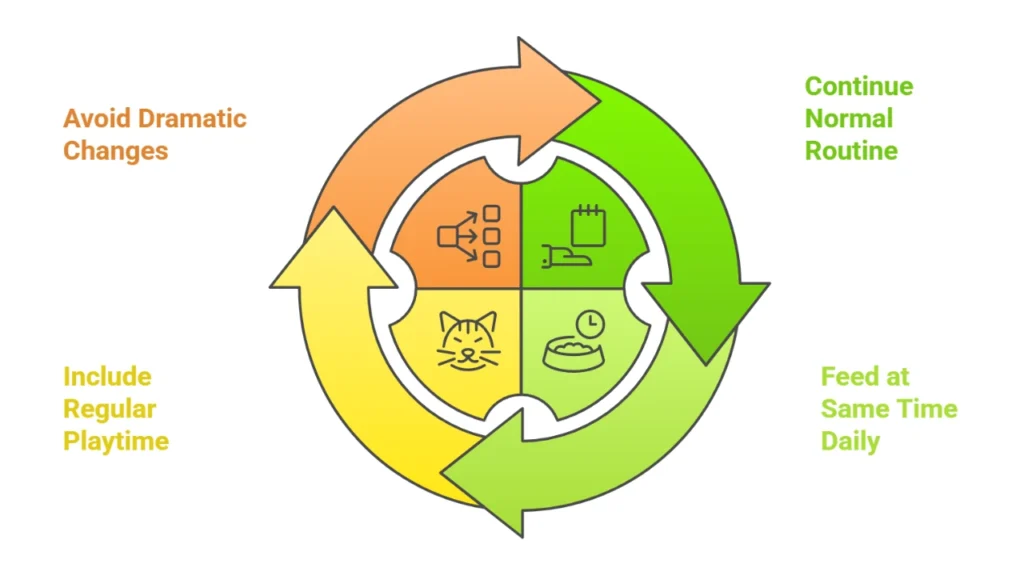
Continue a Normal Routine
Try to replicate the routine your cat was used to before the move. If possible, follow the same:
- Feeding schedule
- Playtime and interaction periods
- Sleep and rest times
Keeping things familiar can make the adjustment process smoother.
Feed at the Same Time Each Day
Cats feel most secure when they know when to expect food. Feed your cat at regular times each day and keep their diet unchanged. If you need to switch food brands, do it gradually – mix the old and new food over several days.
Include Regular Playtime
Playing with your cat helps reduce anxiety and build trust. Set aside time for:
- Interactive play (wand toys, laser pointers)
- Solo play options (balls, puzzle toys)
- Gentle petting and bonding time (if your cat enjoys it)
Avoid Dramatic Changes in Daily Activities
Try to keep household noise and activity levels steady. Cats can become anxious if their environment suddenly changes.
- Introduce new things slowly
- Give them time to adjust
A consistent routine helps your cat feel more comfortable and settle into their new home faster.
Step 4: Gradually Introduce to Other Rooms
Once your cat feels comfortable in their safe room, you can let them explore more of your new home. Expanding their space too quickly can be overwhelming, so it’s best to do this slowly.
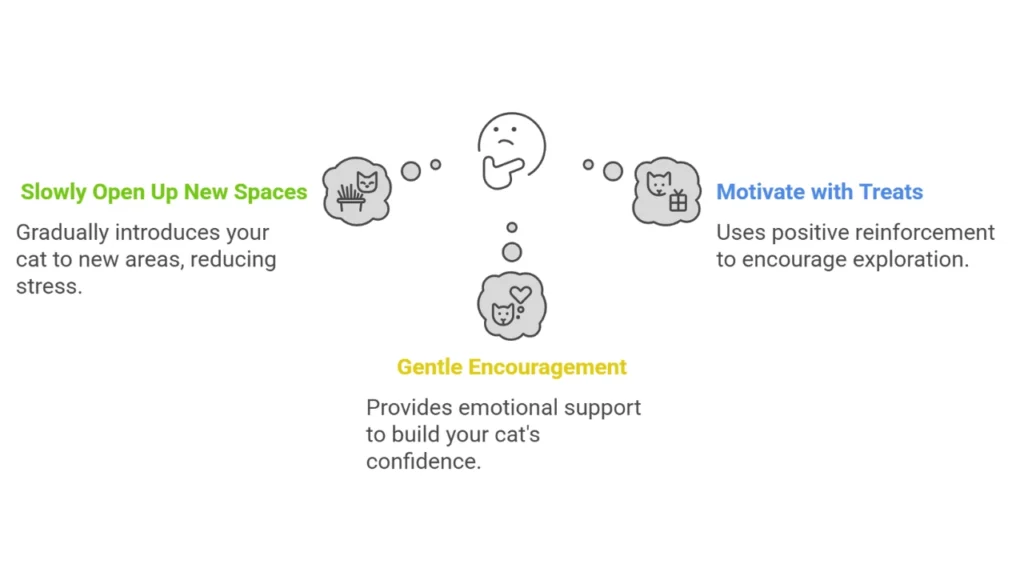
Slowly Open Up New Spaces
Let your cat explore one new area at a time. Leave the door to the next room open and allow your cat to venture out at their own pace.
Avoid picking them up or forcing them into new spaces. If they retreat to their safe room, give them more time before trying again.
Motivate with Treats and Gentle Encouragement
Positive reinforcement helps build confidence. You can encourage your cat by:
- Placing treats or toys in the new area
- Sitting in the room and speaking softly to reassure them
- Keeping the environment quiet and calm to reduce stress
If your cat seems nervous, let them retreat and try again later. Some cats take longer to adjust, and patience is key.
Step 5: Maintain Familiar Scents
Cats rely heavily on their sense of smell to feel safe and comfortable. Familiar scents can help them adjust faster to a new home by creating a sense of security.
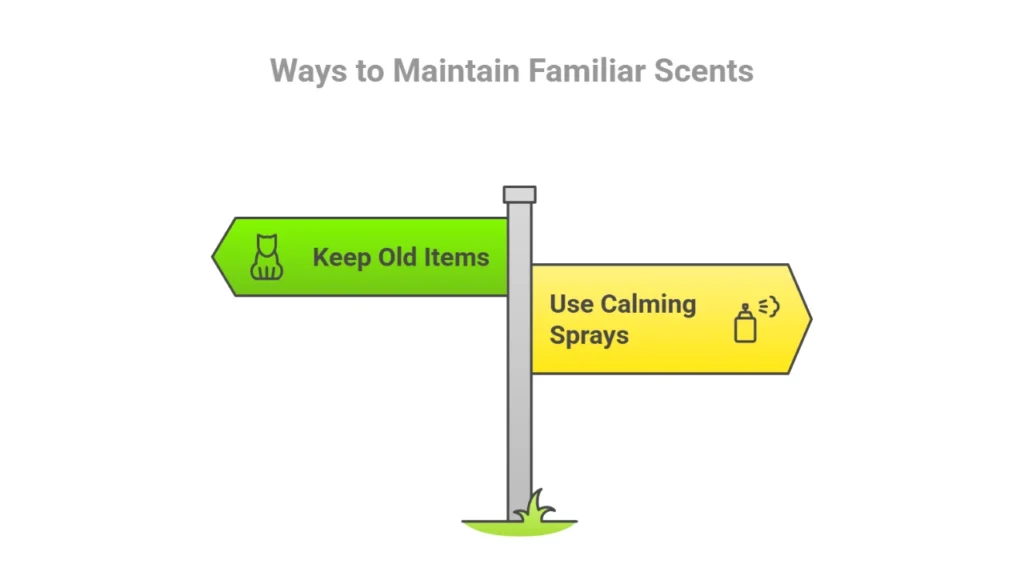
Keep Some of Your Cat’s Old Items
Bringing items from your cat’s previous home can make the transition easier. This helps carry over familiar scents.
Consider keeping items like:
- Their old bed or blanket instead of buying a new one
- Toys, scratching posts, or even a favourite piece of clothing that carries their scent
Avoid washing these items immediately, as the familiar smells help reassure your cat in the new space.
Use Calming Sprays or Diffusers
Calming products can reduce stress and promote relaxation. Consider using:
- Pheromone diffusers to create a calming atmosphere
- Sprays that can be applied to bedding or furniture
These products mimic natural cat pheromones, signalling safety and comfort. They can be especially helpful if your cat is nervous or adjusting slowly.
Keeping familiar scents in the home lets your cat feel more relaxed and confident as they explore their new environment.
Step 6: Monitor Health and Behaviour
Moving to a new home can be stressful for a cat, and changes in behaviour or appetite are common. Paying close attention to their health and emotions will help ensure a smooth transition.
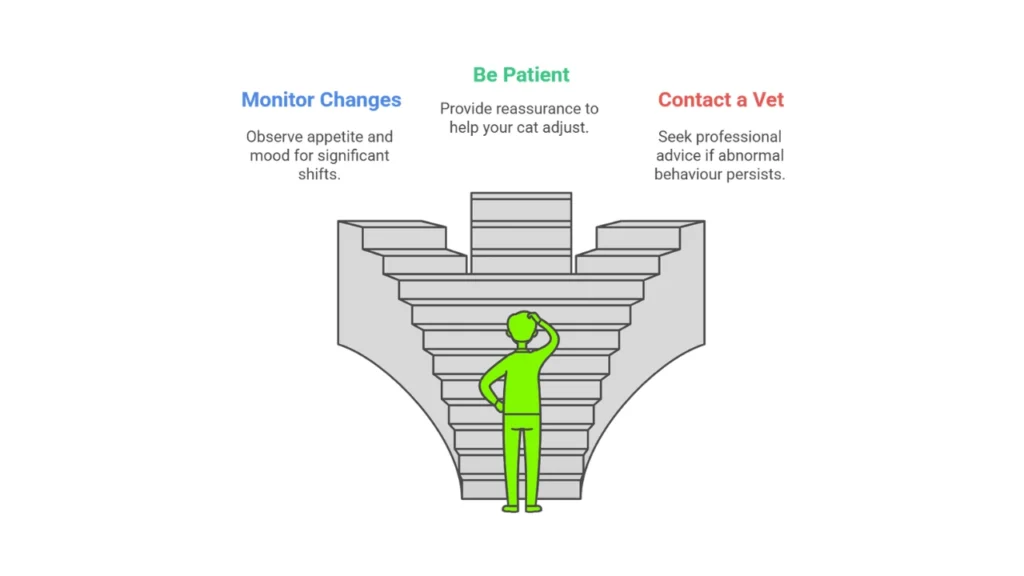
Look for Changes in Appetite or Mood
A cat that is adjusting well should start eating, drinking and using the litter box normally within a few days. Signs of stress or discomfort may include:
- Loss of appetite or refusing to eat
- Hiding excessively or avoiding interaction
- Unusual aggression or excessive vocalisation
Some hesitation at first is normal, but long-term changes may indicate stress or an underlying health issue.
Be Patient and Reassuring
Every cat adjusts at their own pace. Some settle in within days, while others may take weeks to feel completely comfortable. To help your cat feel safe:
- Speak in a calm and soothing voice
- Avoid forcing interaction – let them approach you
- Offer gentle play and treats to build trust
With patience and reassurance, your cat will gradually become more confident in their new home.
Contact a Vet if Abnormal Behaviour Persists
If your cat continues to show signs of stress, refuses to eat, or behaves unusually for more than a few days, consult a vet. They can check for underlying health issues and recommend ways to help your cat adjust.
By monitoring your cat’s health and behaviour, you can ensure they settle in safely and happily.
Step 7: Encourage Social Interaction and Outdoor Exploration
Once your cat feels comfortable indoors, you can start encouraging social interaction and, if appropriate, safe outdoor exploration. This helps them build confidence and feel at home.

Spend Time Playing and Grooming
Regular play sessions help strengthen the bond between you and your cat while keeping them mentally and physically active. Use interactive toys like:
- Wand toys or feather teasers
- Puzzle feeders for mental stimulation
- Soft balls or catnip toys
Grooming is another great way to build trust. Brushing your cat gently can be calming and help them feel more secure in their new environment.
Introduce New People and Other Animals Gradually
If your home has other pets or family members, introduce them slowly to prevent stress.
- Allow your cat to observe from a distance before direct interaction
- Use controlled introductions with short sessions
- Reward calm behaviour with treats and praise
Never force interactions – let your cat approach at their own pace.
Take Them Outside Periodically
If you plan to let your cat explore outdoors, start gradually. Supervised outdoor time can provide enrichment and help reduce stress, but safety is key.
Start in an Enclosed Area or Use a Leash
- If you have a secure backyard or cat enclosure, let them explore within the safety of the space.
- If you plan to take your cat outside on a leash, introduce the harness indoors first and allow them to adjust before going outside.
Not all cats enjoy the outdoors, so observe their comfort level and adjust accordingly.
Encouraging social interaction and safe outdoor exploration can help your cat fully settle into their new home while staying happy and engaged.
Advanced Tips for Helping a Cat Adjust
Once your cat has settled into their new home, you can use additional strategies to help them feel even more comfortable and confident.
Reward Calm Behaviour and Exploration
Positive reinforcement helps your cat feel safe and encouraged. When they explore a new area or show calm behaviour, reward them with:
- A gentle voice to reassure them
- Soft pats or chin scratches if they enjoy physical touch
- Small treats to associate the experience with something positive
Avoid punishing nervous behaviour – patience is key.
Introduce Interactive Toys to Decrease Boredom
Keeping your cat mentally stimulated reduces stress and prevents destructive behaviour. Offer a variety of toys, such as:
- Puzzle feeders to engage their mind
- Battery-operated or motion-activated toys for independent play
- Scratching posts and climbing structures to encourage natural behaviour
A busy cat is a happy cat!
Common Pitfalls and How to Avoid Them
Rushing the Process May Increase Anxiety
Every cat adjusts at their own pace. If your cat is hiding or hesitant, don’t force them out or introduce new spaces too quickly. Let them explore when they feel ready.
Overwhelming with Attention Can Be Counterproductive
While bonding is important, too much attention can make a cat feel overwhelmed. If your cat wants space, respect their boundaries. Let them come to you when they’re ready.
By allowing your cat to adjust at their own pace and using positive reinforcement, you can help them settle in with confidence and ease.
Troubleshooting Common Issues
Even with the best preparation, some cats may take longer to adjust. If your cat shows persistent stress or behavioural problems, try these solutions.
Adjust Strategies Based on Individual Cat Needs
Every cat is different. Some may need more time in their safe room, while others may prefer exploring quickly. Pay attention to their behaviour and adjust your approach:
- If they are hiding too much, give them more time and space.
- If they seem restless or anxious, offer more playtime and interactive toys.
- If they refuse to eat, try different feeding locations or offer a familiar food.
Consult Your Vet to Check Your Plan
If your cat is showing extreme stress, refusing to eat, or acting aggressively, consult a vet. They can check for underlying health issues and recommend calming techniques.
Seek Guidance from Animal Behaviourists If Needed
For severe behavioural problems, such as constant hiding, aggression, or destructive behaviour, a professional animal behaviourist can provide personalised advice. They can help identify triggers and suggest effective solutions for a smoother transition.
Conclusion
Helping a cat adjust to a new home takes time and patience. But with the right approach, they will feel safe and comfortable.
Every cat is different, so be patient and let them adjust at their own pace. If problems arise, adjust your strategies or seek professional advice.
Relocating Your Cat? We Can Help
We help you plan and prepare for a smooth and stress-free pet transport experience.
Whether you’re relocating your cat domestically or internationally, our experts are here to help. We’ve been perfecting pet transport for 50+ years, making us the oldest and most reliable pet transport company in Australia.
With offices and agents spanning every state and territory in the country, we make relocating your cat interstate a smooth process. We advise on the best way for them to travel, whether by air or road.
We also have a global network and trusted travel partners throughout the world. This lets us efficiently transport pets and effectively handle any potential issues to deliver the best international pet transport solutions.
We’ve been delivering stress-free pet transport for 50+ years. Your beloved pet is in safe hands with the experts at Dogtainers.
Get your quote today for domestic or international pet transport.





Share this article